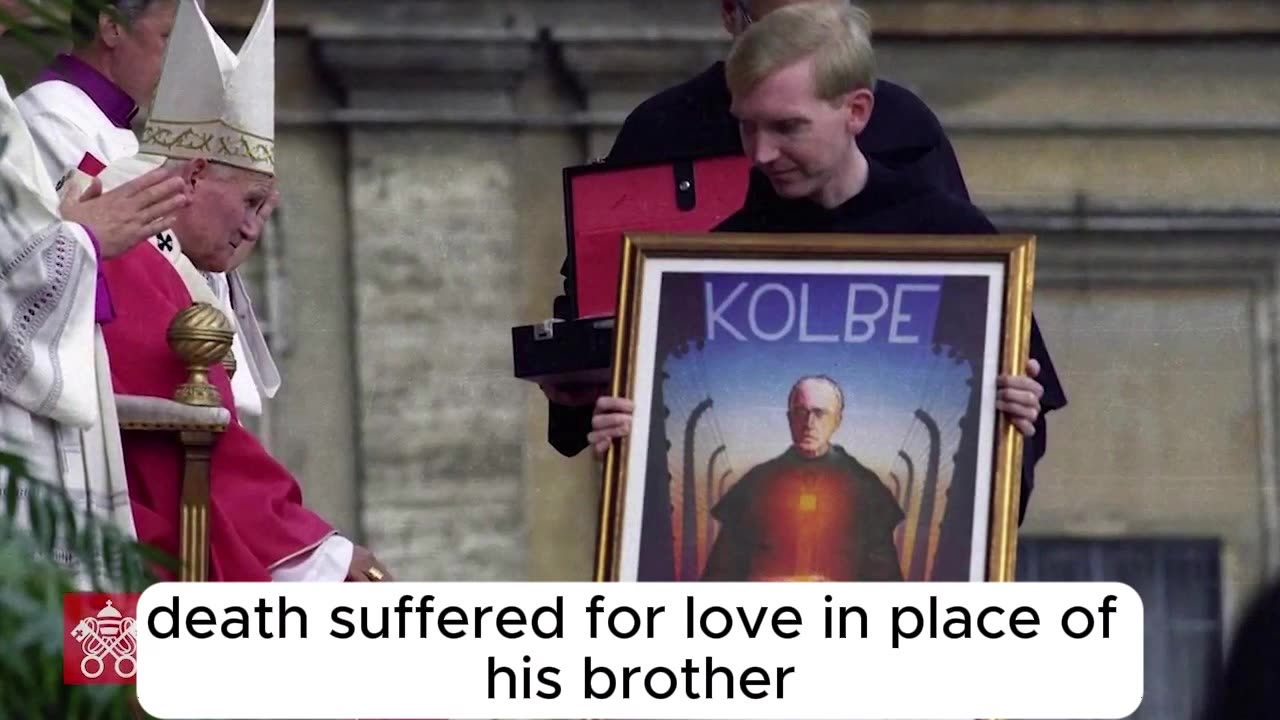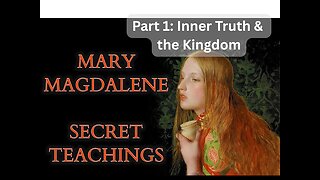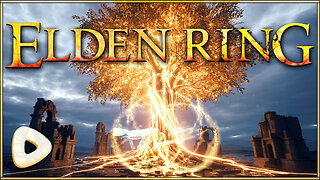Premium Only Content

CANONIZATION OF MAXIMILIAN MARIA KOLBE
CANONIZATION OF MAXIMILIAN MARIA KOLBE
HOMILY OF JOHN PAUL II
St. Peter’s Square, October 10, 1982
Full text available here or below: (translated from italian to english)
https://medium.com/@doubtingtomasz/canonization-of-maximilian-maria-kolbe-4dadd8dc6dc2
1. “No one has greater love than this: to lay down one’s life for one’s friends” (Jn 15:13).
From today, the Church wishes to call “saint” a man who was granted the opportunity to fulfill the words of the Redeemer in an absolutely literal way.
In fact, towards the end of July 1941, when the camp commander ordered the prisoners destined to die of starvation to line up, this man, Maximilian Maria Kolbe, came forward spontaneously, declaring himself ready to go to his death in place of one of them.
His offer was accepted, and after more than two weeks of torment due to starvation, Father Maximilian was finally killed by a lethal injection on August 14, 1941.
All this happened in the Auschwitz concentration camp, where about 4,000,000 people were put to death during the last war, including the Servant of God Edith Stein (the Carmelite nun Teresa Benedetta della Croce), whose cause for beatification is currently underway at the competent Congregation. Disobedience against God, the Creator of life, who said “Thou shalt not kill,” caused the immense slaughter of so many innocent people in this place.
At the same time, therefore, our age has been so horribly marked by the extermination of innocent people.
2. Father Maximilian Kolbe, himself a prisoner in the concentration camp, claimed, at the place of his death, the right to life of an innocent man, one of 4,000,000.
This man (Franciszek Gajowniczek) is still alive and among us. Father Kolbe claimed his right to life, declaring his willingness to die in his place, because he was a family man and his life was necessary for his loved ones. Father Maximilian Maria Kolbe thus reaffirmed the Creator’s exclusive right to the life of innocent men and bore witness to Christ and to love. The Apostle John writes: “We know love by this, that he laid down his life for us; we also ought to lay down our lives for our brothers” (1 Jn 3:16).
By giving his life for a brother, Father Maximilian, whom the Church has venerated as “Blessed” since 1971, became in a special way like Christ.
3. We, therefore, who are gathered today, Sunday, October 10, before St. Peter’s Basilica in Rome, wish to express the special value that the martyrdom of Father Maximilian Kolbe has in the eyes of God:
“Precious in the eyes of the Lord / is the death of his faithful” (Ps 115 [116],15), as we repeated in the responsorial psalm. It is truly precious and inestimable! Through the death that Christ suffered on the Cross, the redemption of the world was accomplished, for this death has the value of supreme love. Through the death suffered by Father Maximilian Kolbe, a clear sign of this love has been renewed in our century, which is so greatly and in so many ways threatened by sin and death.
Here, in this solemn liturgy of canonization, that “martyr of love” of Oswiecim (as Paul VI called him) seems to stand among us and say:
“I am your servant, Lord, / I am your servant, son of your handmaid; / you have broken my bonds” (Ps 115 [116]:1).
And, as if gathering together in one the sacrifice of his whole life, he, priest and spiritual son of St. Francis, seems to say:
“What shall I render to the Lord / for all his benefits toward me? / I will lift up the cup of salvation / and call on the name of the Lord” (Ps 115 [116]:12).
These are words of gratitude. Death suffered out of love, in place of his brother, is a heroic act of man, through which, together with the new Saint, we glorify God. For it is from him that the grace of such heroism, of this martyrdom, comes.
4. Let us therefore glorify today the great work of God in man. Before all of us gathered here, Father Maximilian Kolbe raises his “cup of salvation,” which contains the sacrifice of his entire life, sealed with his martyr’s death “for a brother.”
Maximilian prepared himself for this ultimate sacrifice by following Christ from the earliest years of his life in Poland. From those years came the mysterious dream of two crowns: one white and one red, between which our saint did not choose, but accepted both. From his youth, in fact, he was filled with a great love for Christ and a desire for martyrdom.
This love and desire accompanied him on the path to his Franciscan and priestly vocation, for which he prepared himself both in Poland and in Rome. This love and desire followed him throughout his priestly and Franciscan service in Poland, and also during his missionary service in Japan.
5. The inspiration for his entire life was the Immaculate Virgin Mary, to whom he entrusted his love for Christ and his desire for martyrdom. In the mystery of the Immaculate Conception, the wonderful and supernatural world of God’s grace offered to man was revealed before the eyes of his soul. The faith and works of Father Maximilian’s entire life indicate that he conceived his collaboration with divine grace as a militia under the sign of the Immaculate Conception. The Marian characteristic is particularly expressive in the life and holiness of Father Kolbe. His entire apostolate, both in his homeland and in the missions, was also marked by this sign. Both in Poland and in Japan, the special cities of the Immaculate Conception (Polish “Niepokalanow,” Japanese “Mugenzai no Sono”) were the center of this apostolate.
6. What happened in the starvation bunker in the concentration camp at Oswiecim (Auschwitz) on August 14, 1941?
Today’s liturgy answers this question: “God tested” Maximilian Maria “and found him worthy of himself” (cf. Wis 3:5). He tested him “as gold in the crucible / and accepted him as a burnt offering” (cf. Wis 3:6).
Even though “in the eyes of men he suffered punishment,” nevertheless “his hope is full of immortality” because “the souls of the righteous are in the hands of God, / no torment will touch them.” And when, humanly speaking, torment and death overtake them, when “in the eyes of men it seemed that they were dying…,” when “their departure from us was considered a misfortune…,” “they are at peace”: they experience life and glory “in the hands of God” (cf. Wis 3:1–4).
Such life is the fruit of death in the likeness of Christ’s death. Glory is participation in his resurrection.
What, then, happened in the Hunger Bunker on August 14, 1941?
The words Christ addressed to the Apostles were fulfilled, that they “go and bear fruit, and their fruit remain” (cf. Jn 15:16).
In a wonderful way, the fruit of Maximilian Kolbe’s heroic death endures in the Church and in the world!
7. The men watched what happened in the Auschwitz camp. And even if it seemed to them that a companion in their torment was “dying,” even if humanly speaking they could consider “his departure” as “a ruin,” nevertheless in their conscience this was not merely “death.”
Maximilian did not die, but “gave his life… for his brother.”.
In this death, terrible from a human point of view, there was all the definitive greatness of the human act and of the human choice: he offered himself to death out of love.
And in his human death there was a transparent witness to Christ:
the witness given in Christ to the dignity of man, to the sanctity of his life and to the saving power of death, in which the power of love is manifested.
Precisely for this reason, the death of Maximilian Kolbe became a sign of victory. This was the victory over the entire system of contempt and hatred towards man and towards what is divine in man, a victory similar to that won by our Lord Jesus Christ on Calvary.
“You are my friends if you do what I command you” (Jn 15:14).
8. The Church accepts this sign of victory, won through the power of Christ’s Redemption, with veneration and gratitude. She seeks to read its eloquence with all humility and love.
As always, when she proclaims the holiness of her sons and daughters, so also in this case, she seeks to act with all due precision and responsibility, penetrating all aspects of the life and death of the Servant of God.
At the same time, however, the Church must be careful, in reading the sign of holiness given by God in his earthly Servant, not to overlook its full eloquence and definitive meaning.
Therefore, in judging the cause of Blessed Maximilian Kolbe, it was necessary — already after his beatification — to take into consideration the many voices of the People of God, and especially of our brothers in the episcopate, both in Poland and in Germany, who asked that Maximilian Kolbe be proclaimed a saint “as a martyr.”
Faced with the eloquence of the life and death of Blessed Maximilian, one cannot fail to recognize what seems to constitute the principal and essential content of the sign given by God to the Church and to the world in his death.
Does not this death, faced spontaneously out of love for man, constitute a particular fulfillment of Christ’s words?
Does it not make Maximilian particularly similar to Christ, the Model of all Martyrs, who gave his life on the Cross for his brothers?
Does not such a death possess a particular, penetrating eloquence for our age?
Does it not constitute a particularly authentic witness of the Church in the contemporary world?
9. Therefore, by virtue of my apostolic authority, I have decreed that Maximilian Maria Kolbe, who, following his beatification, was venerated as a Confessor, shall henceforth be venerated “also as a Martyr”!
“Precious in the eyes of the Lord is the death of his faithful ones”!
Amen.
After concluding his homily in Italian, the Holy Father summarized the concept he had just expressed in German.
Dear brothers and sisters of the German language!
Through today’s canonization, the Church presents the heroic sacrifice of Father Maximilian Kolbe as the highest testimony of Christian brotherly love. It took place in the concentration camp of Auschwitz, where, together with him, the servant of God Edith Stein also found death among countless martyred people. The process of beatification has already begun for her as well.
Through his heroic act of love, Father Maximilian Kolbe defended the right to life of an innocent person and affirmed the Creator’s exclusive right to human life. In doing so, he became in a special way like Christ, who gave his life for us on the cross. Let us also follow St. Maximilian Kolbe’s example of Christ in sacrificial, loving service to our fellow human beings!
© Copyright 1982 — Libreria Editrice Vaticana
Copyright © Dicastery for Communication
Original Source: The Vatican
https://www.vatican.va/content/john-paul-ii/it/homilies/1982/documents/hf_jp-ii_hom_19821010_canonizzazione-kolbe.html
-
 5:18
5:18
Doubting Tomasz 2.0
1 day agoGospel of Mary Magdalene - 4 Verses on Inner Truth & the Kingdom
24 -
 LIVE
LIVE
SpartakusLIVE
7 hours agoSNIPING in Battlefield 6 - REDSEC || Monday MOTIVATION to CONQUER the Week
191 watching -
 49:25
49:25
ThisIsDeLaCruz
3 hours ago $0.58 earnedBack Stage Pass with Avenged Sevenfold
31.3K7 -
 6:43:40
6:43:40
GritsGG
8 hours agoWorld Record Win Streak Attempt! #1 Most Wins 3880+!
14.8K1 -
 DVR
DVR
Tundra Tactical
5 hours ago $2.33 earnedProfessional Gun Nerd Plays Battlefield 6
42.3K5 -
 1:01:12
1:01:12
Donald Trump Jr.
8 hours agoThe China Matrix with Journalist Lee Smith | TRIGGERED Ep.288
136K83 -
 11:56:00
11:56:00
Dr Disrespect
13 hours ago🔴LIVE - DR DISRESPECT - ARC RAIDERS - FULL SEND INTO THE RED
157K17 -
 LIVE
LIVE
JdaDelete
4 hours agoFinally playing Eldin Ring | First Playthrough Episode 2
65 watching -
 1:02:08
1:02:08
BonginoReport
6 hours agoNicki Minaj Speaks Out Against Christian Persecution - Nightly Scroll w/ Hayley Caronia (Ep.169)
64.6K43 -
 5:23:36
5:23:36
HomieQuest
6 hours agoLive Streaming! Pokemon Legends Z-A
3.73K3